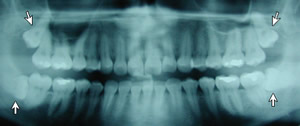|
Impacted teeth are unerupted or partially erupted
teeth that cannot fully erupt due to:
- Lack of space (crowding)
- Misalignment (tooth is rotated out of position)
- Conflicting position (another tooth has erupted over that
position)
- Ankylosis - when other causes of impaction are not corrected
in a timely manner, the roots of the impacted tooth can
fuse to the surrounding bone creating a tooth frozen in
an unerupted or partially erupted state.
The teeth most likely to become impacted are
the third molars, also known as "wisdom teeth."
The first molars are also known as the 6-year molars since
they generally erupt at around age 6, and the second molars
are also known as the 12-year molars since they generally
erupt at around age 12. If the third molars erupted normally,
they might be called 18-year molars. But there is rarely enough
space to fit these last teeth into the small space left behind
the second molars, so the third molars often become impacted.
|
|
|
|
This panoramic x-ray
shows the impacted 3rd molars (wisdom teeth).
The upper wisdom teeth are crowding the sinus cavity
and may erode the roots of the 2nd molars. The lower
wisdom teeth are impacted sideways and are likely
to cause crowding of the lower teeth, leading to malocclusion.
|
The most important thing to know about impacted
teeth is that they almost always require extraction. The longer
the extraction is postponed, the longer the tooth roots grow.
When the tooth roots of an impacted tooth are allowed to develop,
the risk of complication due to extraction increases significantly
because the tooth roots may "wrap around" sensitive
facial nerves.
The risks of keeping an impacted tooth extend
beyond the impacted tooth itself. Any impacted tooth will
exert forces on the arch of your smile that may cause unnecessary
crowding of your teeth. An impacted tooth below the gum surface
may erode the roots of adjacent teeth. An impacted tooth above
the gum line may create a "food trap" that is difficult
to brush or floss and is likely to lead to decay.
If you have an impacted tooth and you are not
FULLY aware of the risks and alternatives associated with
keeping or extracting an impacted tooth, please Contact
Us for an appointment.
|

